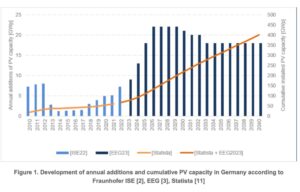- TaiyangNews Special Webinar on HJT technology focused on the cost reduction efforts and technological advancements
- Huasun Energy CTO Dr. Wenjing Wang and Senior Sales Manager Anna Paskaleva shared the benefits of HJT vis-à-vis TOPCon
- Both believe in the potential for HJT to become a mainstream technology in the near term
Heterojunction (HJT) has established itself as a high efficiency crystalline silicon solar technology. Its popularity has grown exponentially over the last few years. A leader on the matrix of temperature coefficient, bifaciality and low light response for various applications, HJT players have been undertaking various technological advancements that have significantly reduced costs for this technology.
In a Special Webinar on Heterojunction Technology with HJT leader Huasun Energy, TaiyangNews attempted to understand the winning formula of achieving a competitive levelized cost of electricity (LCOE) with this technology.
In a very comprehensive presentation, Huasun’s Chief Technology Officer Dr. Wenjing Wang shared the company’s cost reduction efforts for HJT with silver-coated copper electrode and zero busbar (0BB) technology.

He touched upon cell efficiency progress as well as module power progress at Huasun. Starting with 24.5% cell efficiency in 2021 under HJT 1.0, Huasun has already reached HJT 3.0 in 2023 with 25.5% efficiency using doped microcrystalline thin film on the double side being the key. The technology offers a room to improve it further beyond 26%, Wang emphasized.
In fact, the company has attained an average efficiency of 26.15% with its golden line following a so-called HJT 3.0+ process. The key features of this approach include using silicon wafers high lifetime, lowering the deposition rate of PECVD tools, narrowing ITO-free edges, employing silver paste, increasing the finger density, especially on rear side and using steel mesh for metallization.
However, these parameters, at least not all, can be implemented in very high-volume production directly. In mass production, the efficiency has to be balanced with cost, stressed Wang. This implies adapting a few low-cost practices such as opting for wafers with relatively lower lifetime, higher deposition rates in PECVD, and using silver-coated copper paste on both sides. This would result in a relatively lower efficiency of 25.7% to 25.8%.
Experimenting several mix and matches, for example, replacing the high lifetime wafers with lower one in the golden line parameters, Huasun was able to attain about 26.1% to 26.3% average. Use of steel mesh screen printing is a major contributor to this improvement, he added.
To further increase HJT cell efficiency in mass production, Huasun also developed a process called HJT3.0++, in back polishing. Wang said it is applied in addition to employing RPD for ITO deposition, to reach an efficiency of 26.5%. However, Wang emphasized that the process is still not in mass production.
With a high efficiency solar cell, module power can reach up to 725 W in mass production. However, Huasun has already managed to achieve a module power of 750.54 W with 24.13% module efficiency for G12 132-half cut cell in lab.
According to him in China, manufacturers are currently working on 4 different technical routes for 0BB. These are SWCT developed mainly by Meyer Burger; integrated film covering (IFC) developed by XN Automation and Maxwell; dispensing developed by Autowell; and welding+dispensing developed by Maxwell.
Huasun has opted for the welding+dispensing technology for 0BB. It prefers 0BB since it can reduce consumption of silver paste, improve module reliability, is compatible with thinner silicon wafers and provides optical advantages.
Dr. Wang added that the introduction of 0BB into mass production will further decrease the cost of HJT. Combined with the copper-silver paste, the silver consumption can also be decreased to 7 mg/W.
Discussing about the company’s technology at the product and system level at the webinar was Huasun Energy’s Senior Sales Manager for Europe, Anna Paskaleva.
Drawing a comparison with another key technology in the market today, TOPCon, Paskaleva said HJT has proven itself as a superior technology in terms of reliability, temperature coefficient and power degradation. Compared to TOPCon’s -0.29%/ºC, it has achieved a low temperature coefficient of -0.24%/ºC that helps control power output as it gets impacted with high temperature. She stressed that this is the reason why many developers in hot climates prefer HJT right now.

At present, Huasun works with 4 main sizes of cell development, namely G12R 96 cells for residential; G12R 108 cells for C&I, along with G12R 132 cells for larger C&I projects as well as for utility scale facilities. It uses G12 132 cells module is dedicatedly for the utility scale segment.
Sharing some case studies for HJT projects vis-à-vis TOPCon technology, Paskaleva stressed that HJT delivers higher energy yield.
Talking about balance of system (BOS) which refers to all other components of a solar power system except modules, Paskaleva said HJT modules reduce use of racking materials and land by 4.8% each, compared to TOPCon.
In a utility scale installation, she explained that 210R HJT modules with higher yield contribute to lower LCOE, higher project return with -2.6% LCOE compared to TOPCon. The return on investment is estimated to be 3.9% more. The world’s largest HJT utility scale project at present is a 650 MW facility in Bulgaria for which Huasun is the module supplier.
Panel discussion
Despite all the cost reduction efforts, HJT is still considered an expensive technology compared to its peers TOPCon and PERC. With all the technological advancements taking place, can HJT compete with its peers on cost/W basis was the question that the panel, moderated by TaiyangNews Senior Editor Anu Bhambhani, attempted to discuss.
Huasun CTO Dr. Wenjing Wang believes that the cost per watt gap between HJT and TOPCon will reduce very quickly. The gap is around 5% to 10%, but it is flexible.
The basic idea of HJT solar cell can be produced with lower cost materials such as copper replacing silver. However, he pointed out that if the material prices increase then the gap between HJT and TOPCon can come down to even zero.
Referring to the company’s lower cost module variant, Anna Paskaleva said Huasun obliges customers when they request for a low-power output module. This is especially the case with projects that were initially designed with PERC or TOPCon and now being shifted to HJT. She argued that while HJT can lower power output, TOPCon can’t. This way, Huasun is able to match the price of TOPCon.
Wafer thickness reduction is a significant factor to reduce costs. Wang shared that Huasun currently has a wafer thickness of around 120 μm and targets to bring it down to 110 μm by the end of 2024. For TOPCon, it is much higher at 130 μm.
Over the next 4 years, Paskaleva sees HJT becoming the new mainstream technology taking over from TOPCon, just as TOPCon has taken over from PERC. She attributed this confidence to Huasun’s customers who want to stick to the technology for all their future projects. The year 2024 will be the turning point for HJT.
She also expects HJT combined with perovskite in tandem will be in mass production as the next mainstream technology.
Dr. Wang sees market share for HJT and TOPCon growing to 50:50 over the next 4 years even though this year and next he sees TOPCon to become mainstream.



